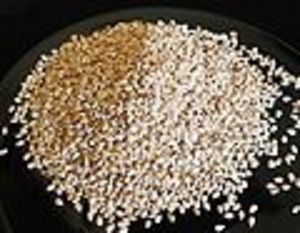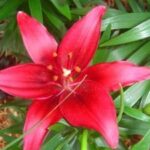Sesame seeds are usually used to decorate burger buns or specialty breads but contrary to general opinion, these crunchy seeds are actually quite nutritious. Sesame seeds are produced from the plant called Sesamum indicum, L, or bene, which is native to Africa, Asia Minor, and tropical countries. You can easily enjoy these nutty, versatile seeds and their beautiful flower blooms by growing them yourself.
Sesame can be grown twice annually. One crop can be sown in early spring and the other in July. Sesame can be started indoors and transplanted when the outdoor conditions are warm enough to promote growth. The seed should be started early enough in the spring to allow for a good growing season. Plant the seeds six inches apart in moderately rich soil with full sun exposure.
The plant will grow thick, bushy, and erect with spires growing up to 72 inches in height. The beautiful, creamy yellow-lavender sesame flowers bloom from July to September and are similar in shape to foxglove. If the plants tend to fall down stake them or plant in compact groups to hold each other upright. Plants that are growing too thickly can be thinned and transplanted during the evening hours. Water transplanted plants heavily to prevent wilting.
Sesame has a taproot system and a secondary root system. This enables the plant to absorb moisture from the subsoil and surface area very effectively. Although sesame thrives in well-drained, neutral, rich soil, it can also be planted successfully in less than ideal soil conditions. Since sesame plants deplete the soil of some nutrients, it should not be planted in the same garden area each year.
Each sesame plant can produce up to 50 seedpods on each branch with four to six branches. The soft seedpods are long and four-celled containing numerous tiny seeds that are flat and usually cream colored. Some varieties produce seeds that range in color from white to black. Pick the pods when they burst open and after they become brown and dry but before they turn brittle. Place them on trays and shake out the seeds. The seeds can then be hulled and winnowed. The seed must be hulled before eating because their outer skins contain oxalic acid, an irritant to the stomach lining. Once the seeds are hulled, they are easy to digest. Sprouting the seeds will also increase their nutritional value. Refrigerate the seeds to prevent spoilage. Sesame should be harvested before the first frost.
Sesame seeds contain a protein content that is similar to beef and it is also a valuable source of most essential amino acids. Sesame seeds are a good source of vitamin E and lecithin. The seeds can be combined with honey and other dried fruit to make delicious energy bars or the Middle Eastern confectionary, Halvah. Oil can be extracted from the seeds by bruising them and then immersing the bruised seeds in hot water. The oil rises to the surface and is skimmed off. Sesame seeds can also be added to breads and pastries to increase the nutrient and fat content. The seeds can be liquefied to produce Tahini, a rich, creamy butter with a distinctive roasted nut flavor.






